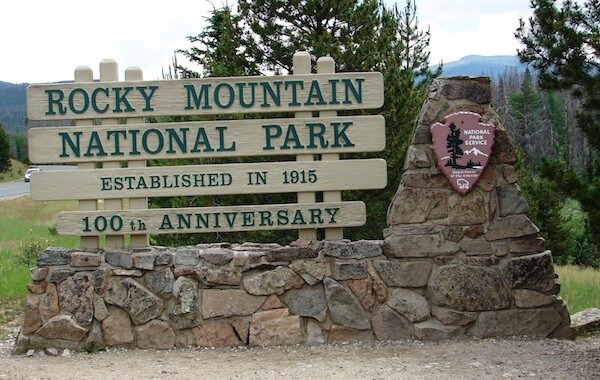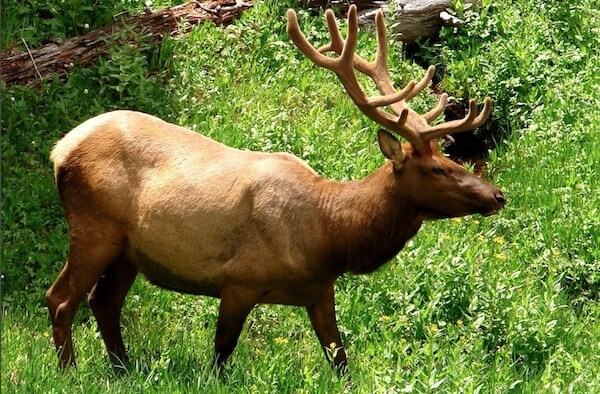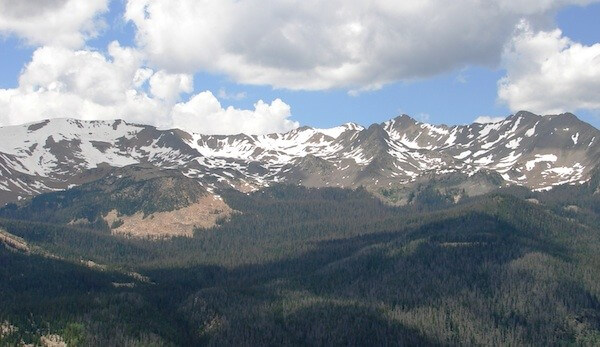
As I was just about to enter into Colorado’s Rocky Mountain National Park on my recent visit, I paused to take a photo of the special sign that had been added for this year. After all, this park was first established on Jan. 26, 1915, so the sign indicated that this year was its “100th anniversary”, and there were a number of special events taking place in celebration of this milestone. I decided to participate by returning to this awesome park during this special time.
High and Wild
I have to admit that I’ve always found its Alpine Visitor Centre, located near the summit, particularly appealing, for it’s the highest one in the country’s entire National Park Service, and it offers extraordinary alpine tundra views. While up here this time, I again ascended its steep Alpine Ridge Trail on foot, from which wildlife is often visible, for one’s added ‘viewing pleasure’. For example, I can recall that on the first time that I ascended this trail, I saw a herd of elk in the valley below! On this particular trip, I saw both elk and moose in the park, and I was able to get some great photos. Other wildlife often seen includes deer, coyote, bear, and bighorn sheep. Also here, but less likely to be seen, are bobcats and mountain lions.

Snow in July
It was early July when I visited this time, and there was still quite a bit of snow around me, even though the air temperature was quite warm. I even watched a couple of people actually throwing snowballs at one another near the summit! This summer snow certainly makes it easier to understand why this road and area is not open year-round, for although some of the park is always available, the entire Trail Ridge Road, that traverses the park, is only open from about Memorial Day to mid October, for there’s just too much snow during the remainder of the year. After all, the Trail Ridge Road is the highest continuous paved road in North America (rising to over 12,000’), and this park has the highest average elevation of any national park, with about one-third of this park being above the tree-line. However, the good news for the avid cyclist is that the Trail Ridge Road is usually open to cyclists in April, long before it’s open to motor vehicle traffic, and some of the park’s roads are open year-round for the two-wheeled adventurer, such as Upper Beaver Meadows Road and Endovalley Road.
A Summer Ride
Most of us, however, are going to plan our cycling trip into Rocky Mountain National Park for the summer, and we’ll then be accompanied on the roads by lots of motor vehicle traffic. Therefore, it’s best to plan to ride in the early morning – when the traffic may be lighter and the opportunities for wildlife viewing may be higher. The majority of severe thunderstorms (with lightning) seem to occur here in the late afternoon, so it’s best to be off the road at that time anyway.
Most of the cycling route will have narrow or no shoulders, and the elevation levels will range between 8,000’ to more than 12,000’ (2,400 to 3,700 m), so expect some long, tough, leg burning climbs, with 5-7% grades, followed by adrenaline-pumping descents. Dress in layers, for the weather is very unpredictable and quick-changing – and carry drinking water and snacks. The park will charge you $10.00 for a week’s pass per bike.
If you ride the entire Trail Ridge Road, you’ll find plenty of pull-outs and photo ops, and you’ll encounter lava cliffs, rock cuts, thick forests, magnificent wildflowers, deep valleys, and hairpin curves. One of the highlights for me was Milner Pass, for here I found a sign indicating that I was at the Continental Divide, which separates drainage to the Atlantic Ocean and the Pacific Ocean.

Hiking Trails
Apart from the challenging cycling, the spectacular views of snow-capped mountains, and the proximity of an abundance of wildlife, I’m also drawn to this park for its plethora of fascinating hiking trails, and I’d definitely take time to ditch the bike and do some walking, too. For example, I hiked three trails on this visit: the Alpine Ridge Trail, the Coyote Valley Trail, and the Adam Falls Trail. There are, of course, many other worthwhile treks available, such as the relatively short Bear Lake, Sprague Lake, and Lily Lake Trails, as well as many longer trails that lead into the backcountry. If you wish to explore further, be sure to pick up the required backcountry camping permit.
The park’s hiking trails are all off-limits to the mountain biker, but there are plenty of opportunities in the nearby Roosevelt National Forest (east of the park, near Estes Park) and at the Winter Park Resort (just west side of the park, near Grand Lake). Also, the entire 48 mi/80 km Trail Ridge Road that takes you through the park, between Estes Park and Grand Lake, is a definite must! Another challenging gravel road ride in the park is the Old Falls River Road, but it’s only open to cyclists between June 1 and July 4, and only on Sat., Sun., and Mon. (it’s a rather thin window of opportunity); however, this narrow road, with its many switchbacks, will take you to Chasm Falls and the Fall River Pass (near the Alpine Visitor Centre).
An Easier Option
If you want to have a thrilling bike ride without all that gruelling climbing and exertion, it’s possible to join a guided tour from Estes Park with Colorado Wilderness Rides and Guides (www.coloradowildernessridesandguides.com/biketours). They’ll drive you to the summit of Trail Ridge Road, and then you’ll descend back to Estes Park, stopping for lunch along the route at Horseshoe Park.
Verdict:
The centennial celebration may be ending, but Rocky Mountain National Park is still definitely worth checking out.
For More Information: www.rockymountainnationalpark.com